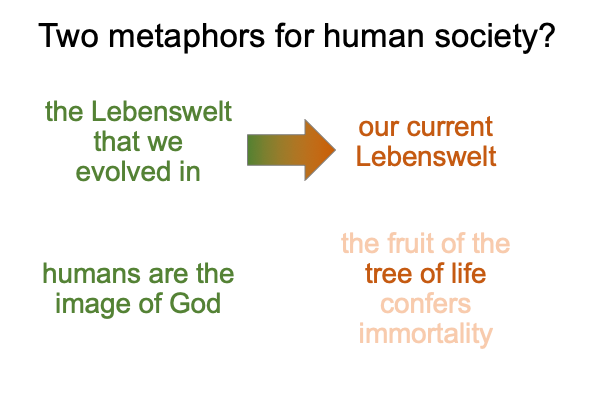0070 In chapter five, Mark Smith asks, “When does the story of human sin begin in Genesis?”
0071 At this point, conditions further clarify.
The first audiences for the early stories of Genesis are children. The first authors are their mothers, the daughters of Seth. Eve is their great-great-…-great grandmother. The stories convey to each child this lineage, a direct descent to this mother, who is center stage. Eve is more than a foolish woman who talks to serpents. Eve is your mother as well.
0072 What does it mean to be a mother, a woman, cursed under Eve’s indictment?
A Primer on the Family presents the family as a prototype of the corporation, the content level of the organization tier. Eve, the woman, is the producer. Her man is the management. Her children are the service, or, in today’s terms, the human resources. Eve does not change the centrality of the mother. She magnifies it.
She offers a warning.
0073 The story of Eve’s temptation offers many lessons, including ones on the nature of desire. As Smith points out, Genesis 3 portrays a deeply disturbing psychological narrative. Don’t all good fairy tales?
Plus, I add, Eve’s narrative, along with other Genesis stories, captures the weirdness of the constellation of unconstrained social complexity during the Ubaid. Adam and Eve are made in paradise, eat from the tree of the knowledge of good and evil, and are expelled. Neither Genesis 2 nor 3 use the word, “sin”. The label, “evil”, is only mentioned in the name of the infamous tree.
Afterwards, Eve bears two children, Cain and Abel. Eve is the producer.
0074 “Sin” is mentioned in Genesis 4, along with the word for desire, “teshuqah”. Desire appears in the temptation of Eve and in her rebuke, where God says, “Your desire will be for your man.” Yes, the woman will desire her man to be her manager. There is no sin in that.
So, where does the word, “sin”, first appear?
When Cain, the gardener, complains about God preferring burnt offerings of meat, God offers a revealing repost, saying (more or less), “If you do what is right, you can bear it. If you do not do right, sin crouches at your door. Its desire (teshuqah) is for you, but you can rule over it.”
The word, “sin”, appears for the first time. It does so in conjunction with a desire that crouches, like a predator, at Cain’s threshold. Cain can rule it. Or, it can rule Cain.
We all know what happens next.
0075 The daughters of Seth do not pull punches. This conjunction of “sin” and “desire” is so provocative that I wonder, what child would not remember it, later, as an adult?
Even more intriguing is how this conjunction exposes a disquieting reality within the Ubaid’s spiral towards unconstrained social complexity. The idea of one brother killing the other is not out of the question. Why? Such killingis an artifact that validates what the murderous brother has been telling himself.
0076 In hand-speech talk, gesture-words picture or point to their referents. So, the words cannot lie about what they refer to.
In speech-alone talk, spoken words do not picture or point to their referents. Instead, we construct artifacts that validate our projection of meaning, presence and message. We speak, and the world comes into creation. Not just any creation. Our creation. Our imagination constructs artifacts that validate our spoken words.
0077 Oh, those damned artifacts.
When fatty portions are added to a fire, the fire jumps to life.
When cabbage is added to a fire, the fire smolders.
0078 One son does not talk to himself. Instead, he praises God.
The other mutters under his breath. He complains about God’s rejection of his artifacts.
0079 The children hear a fairy tale, telling them of dangers in their upcoming lives.
The mothers hear the tragedy of two sons, where one rules over his desires and the other does not.
0080 This is one of the poisonous fruits of the tree of the knowledge of good and evil, the tree of speech-alone talk. I can create my own world through my own symbolic actions that simultaneously do not honor God and open the door to the one whose desire is for my desire.
Sin crouches at Cain’s door. It desires to speak to him.
Behold the fruits of the tree of death.


